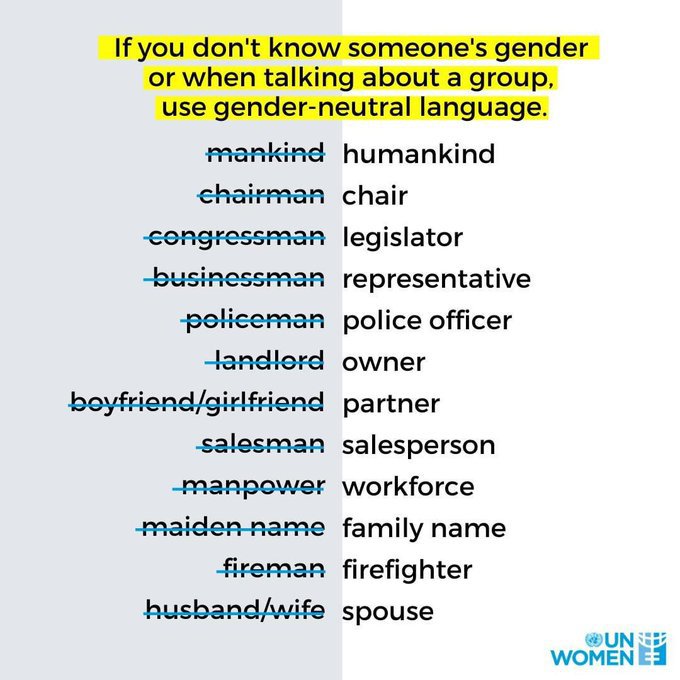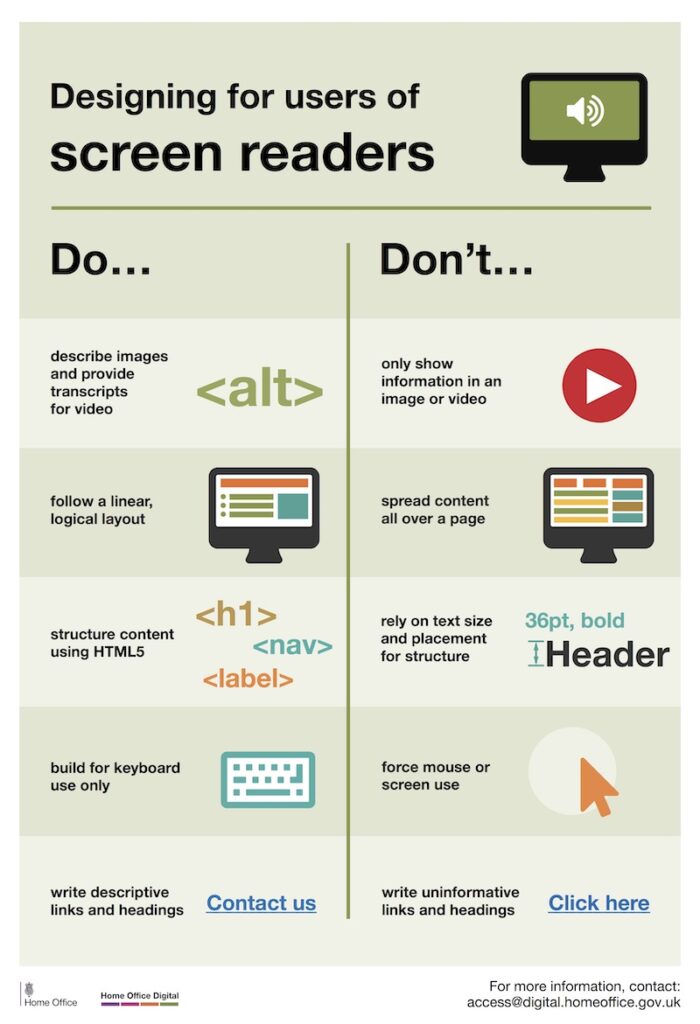Content is powerful. It can empower and lift up just as easily as it can exclude and put down. Over the past year in particular, we’ve had several opportunities to learn how language and imagery can be (and have been) used to other and marginalize, as well as how we can choose respectful, inclusive messages that embrace differences.
In June 2020, the Associated Press announced that it would be capitalizing the “b” in Black in order to recognize and show respect for the “essential and shared sense of history, identity and community among people who identify as Black.” Earlier, in May, the United Nations tweeted a list of gender-inclusive terms to promote greater awareness around gendered language.

Similarly, 2020 has seen more and more people specifying their personal pronouns on social media platforms as part of a continued effort to normalize the practice in solidarity with trans and non-binary folks.
We’ve even seen this push for greater inclusion taken beyond words into visual mediums, with ever-stronger calls for greater on-screen diversity and representation through movements like #OscarsSoWhite and #BaftasSoWhite.
Why inclusive content matters
From these examples—and many others like them not listed here—it’s clear that there are a lot of people out there looking for content that speaks to a wider, more diverse audience. From the photos we choose for our websites to the words we use in our social media copy, now more than ever there’s an expectation to express ourselves in a way that’s inclusive. Failing to do so not only puts you at risk of excluding certain communities, but also signals an unwillingness or inability to learn and grow.
At our core, the VeraContent team is a group of people passionate about communication. Naturally, inclusive language and content has long been a topic of interest for us, inspiring plenty of eye-opening chats on our team Slack. We get to debate topics like what’s problematic about translating a historical figure’s name, how we can identify (and stop using) idiomatic phrases with racist origins, and how to make the texts we work with more gender inclusive.
This year we decided to turn all of this interest into action. We founded VeraImpact, a small group of team members dedicated to creating and developing initiatives that promote inclusion and social awareness within the company.
The six steps laid out in this article come directly from my experience as a member of the VeraImpact committee. In sharing these lessons, I hope to provide you with the inspiration you need to start creating more inclusive content in a meaningful way, while demonstrating a genuine commitment to inclusion.
1. Read up on inclusive language.
An important first step on your inclusive content journey is to roll up your sleeves and do the research. Type “inclusive language” into Google and you’ll find a whole host of articles offering a solid introduction to this concept. To avoid information overload, we suggest you start by exploring the principles of inclusive language, or the ideas and beliefs that guide inclusive phrasings and word choices.
Here are a few points worth highlighting as you get started, taken from VeraContent’s very own tone and style guide for inclusive language:
- Language is always evolving. Language develops within a social context, and is always changing as a result of social growth and transformation.
- Think about the audience. You never know who will be engaging with your content, so you should always imagine that your words will be received by a diverse audience.
- Respect comes first. A respectful, considerate mindset must be at the core of your approach to inclusive language.
- Develop a critical eye. Cultivating a more critical perspective will allow us to consider new perspectives and detect areas where language can be more inclusive.
See also: What is inclusive language? Key examples from VeraContent’s tone & style guide
2. Find your blind spots.
Now it’s time for some introspection. Reflect on who you’ve been creating content for, and the ways in which you may have unintentionally excluded or othered certain people and groups with your content.
Here are three ways to assess your content:
1. Write a detailed description of the persona(s) who you’ve created content for. Then think about who is represented, and who isn’t.
2. Get a third-party perspective, perhaps from someone in your network with a background in Diversity & Inclusion.
3. Take a quiz that detects your own unconscious bias, like these tests from Project Implicit.
This can be an uncomfortable process for many of us. However, identifying our biases and what we’ve been overlooking is crucial if we hope to create more inclusive content in a way that’s both meaningful and sustainable. In other words, we need to know where we’re coming from to get to where we want to be.
3. Set your intentions.
The next step is to ask yourself why you want to make more inclusive content. What is the intention behind your inclusive content plan? Do you simply feel like it’s the right thing to do? Do you believe it’ll represent your values more accurately, or lead you to more professional opportunities?
More often than not, it will be some combination of these ideas. In any case, understanding what’s driving your inclusive language journey will give you a better sense of direction when it comes to goal setting.
We recommend listening to this podcast as you think about the role you want to play in Diversity & Inclusion.
4. Create an inclusive content implementation plan.
Laying out your inclusive content goals will not only help you to track your progress, but also to develop a long-term commitment to building inclusive content.
As you define your short- to long-term goals, it’s crucial to include a healthy mix of small-scale, realistic tasks and big-picture, transformational aspirations. If you only go for one or the other, your goals will either fall short of bringing about meaningful change, or be too lofty to make any kind of real impact.
To help you get started with your implementation plan, check out this LinkedIn Learning course on driving change and anti-racism, which I found really helpful.
5. Develop guidelines for inclusive content.
While short-term goals are sure to vary based on your intentions, developing inclusive content guidelines should be near (if not at the top) of your list.
There are a few ways to go about this, and your approach will depend on the primary area of content you work with. For example, a project manager at a multilingual content agency might be more likely to focus on building an inclusive language guide, whereas a marketing manager may be more preoccupied with their company’s web or app accessibility.
No matter what your main focus is, when developing inclusive content guidelines, you should consider four main areas:
1. Inclusive language. How can you write in a way that respects and recognizes the groups and people referenced in a piece of content?
2. Diverse sources. How can you reflect diversity in your choices of sources, authors, examples, quotes, interviews, and so on?
3. Accessibility. How user-friendly is your website or app for people with different kinds of disabilities? Read this article to learn about the importance of web accessibility.
4. Visual inclusion. How well do your visual choices represent your audience? Here’s a great site where you can find inclusive stock images.

6. Be curious and open to feedback.
When it’s done right, the final step on this list is never complete. Why? Because an open and honest dialogue is central to developing an inclusive mindset—one that will not only help us choose better words and enhance our content in the process, but that will allow us to promote inclusion in the different arenas where we find ourselves.
With this in mind, stay curious and embrace the feedback that comes your way. As you work on the different points discussed in this article, invite other people into the conversation by asking for their thoughts and advice. This will help you to build a positive and collaborative approach to inclusive language, and to demonstrate a genuine investment in continued learning.
Final thoughts on inclusive content
At its core, inclusive content is about compassion, respect and empathy. It isn’t about knowing the rules, avoiding criticism, being politically correct or jumping on a bandwagon. It’s about making choices out of a genuine care and concern for others, and expressing our deepest values in a visible way.
The steps outlined in this article are just the beginning of a lifelong learning process. My advice? Keep your mind and your ears open, be kind, and never stop asking questions.
Ready to start your inclusive content journey? Check out some of these great resources:
- Guide: Inclusive Language and Vocabulary for Startups and Tech
- Courses in Diversity and Inclusion from Coursera
- Web Accessibility Initiative: Guidelines and Resources
Also check out our interviews with content marketing experts across Europe:
- Diversity in marketing is paramount – Tina Morwani
- Commitment without action means absolutely nothing – Luc Berlin
- Build a socially conscious brand – Yaron Hubin Plimmer

